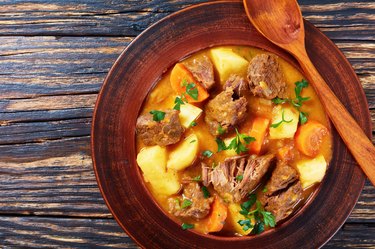
If you're looking for a hearty, substantial meal, stew is a prime choice. However, the flavorful dinner can easily fall flat without its trademark rich texture.
To help your supper live up to expectations, you might have to try a thickening agent. While it's not always required, it will help you more precisely achieve the ideal thickness you are looking for, Michele Sidorenkov, RDN and chef, tells LIVESTRONG.com. And when it comes to thickening agents, flour is a great option. Find out three ways you can use this kitchen staple to thicken your next stew.
Video of the Day
Video of the Day
1. Dredge Meat in Flour
Cooking flour-coated meat is an easy way to thicken your stew, says Sidorenkov. "By adding flour at this early stage, you'll help your meat stay flavorful and tender," she says.
What You'll Need
- Beef
- Paper towels
- Flour
- Herbs and spices (optional)
- Mesh sieve (optional)
How to Do It
- Cut your meat into cubes. Pat the cubed meat dry with a paper towel.
- "Add seasonings to your flour mixture before dredging to help infuse even more flavor into the meat before cooking," says Sidorenkov.
- Evenly coat the cubes of meat in the flour and shake off any excess.
Tip
“Using a mesh sieve to toss and flour your meat at the same time will help evenly coat each piece and let the excess flour fall away,” says Sidorenkov.
2. Make a Slurry
One of the best ways to control a stew's texture is to mix flour with water or stock. This combination of flour and a liquid is known as a slurry, and you can add it slowly into the pot as you cook your stew, until you've reached the desired thickness.
What You'll Need
- Stew
- ¼ cup of flour
- ¼ cup of water or stock
- A container with a lid, such as a mixing bottle or shaker
- Tablespoon
- Stirring spoon, such as a wooden spoon
How to Do It
- Measure ¼ cup of flour and ¼ cup of water or stock and pour it into a container with a lid.
- Place the lid onto the container and shake for 30 seconds to mix.
- Measure out 1 tablespoon of the flour and liquid mixture and add it to the stew. "Add your slurry to the stew while the liquid is simmering, when you're nearing the end of cooking," advises Sidorenkov.
- Stir the stew with a wooden spoon until the slurry is well-incorporated. Let it return to a simmer.
- If the stew still needs a thicker consistency a fter 2 to 3 minutes, repeat the process until it reaches your desired consistency.
Tip
The larger the pot of stew you have, the more flour mixture you'll have to incorporate. If you’ve made a very small pot to serve one or two people, you can decrease the amount of flour and liquid used to make the slurry by half to avoid waste.
3. Thicken Stew With a Roux
A roux is a classic technique to thicken stews, casseroles, gumbos and other dishes. To make a roux, combine flour with fat (instead of a liquid, as in a slurry). You'll want to make your roux after searing your meat — but before adding liquid to the pot, says Sidorenkov. "Adding flour to a warm oil helps break down flour's starch molecules, which helps prevent gelatinization and clumping," she says.
What You'll Need
- 2 tablespoons of butter
- 2 tablespoons of flour
- Wooden spoon for stirring
How to Do It
- Sear meat or vegetables in oil.
- Add 2 tablespoons of fat. You can use either butter or oil. Then, add an equal amount of flour.
- Whisk the flour and butter together continuously for several minutes, until the mixture is light brown.
- Slowly add the stock and cook the stew.
Warning
Make sure to cook the flour regardless of the stage you add it to your stew. “Uncooked flour has a very unpleasant taste!” says Sidorenkov.
Alternative Thickeners to Flour
If you don't have flour on hand — or you'd rather try a different ingredient — you can use cornstarch to create a slurry as well. "To make a cornstarch slurry, whisk together two parts cool water to one part cornstarch, and then whisk the slurry into the hot stew liquid," says Sidorenkov. Then, let the cornstarch flavor cook off for about five minutes.